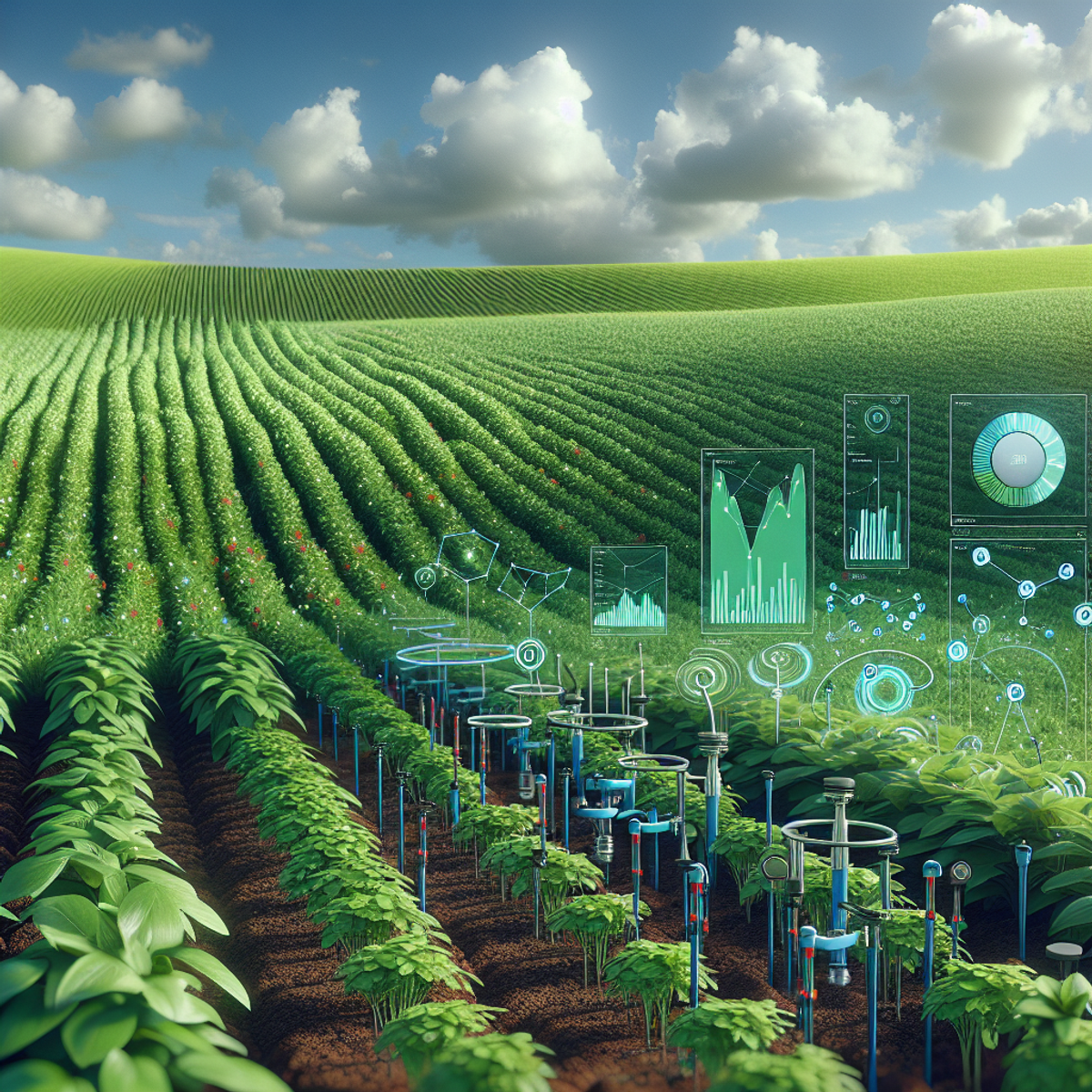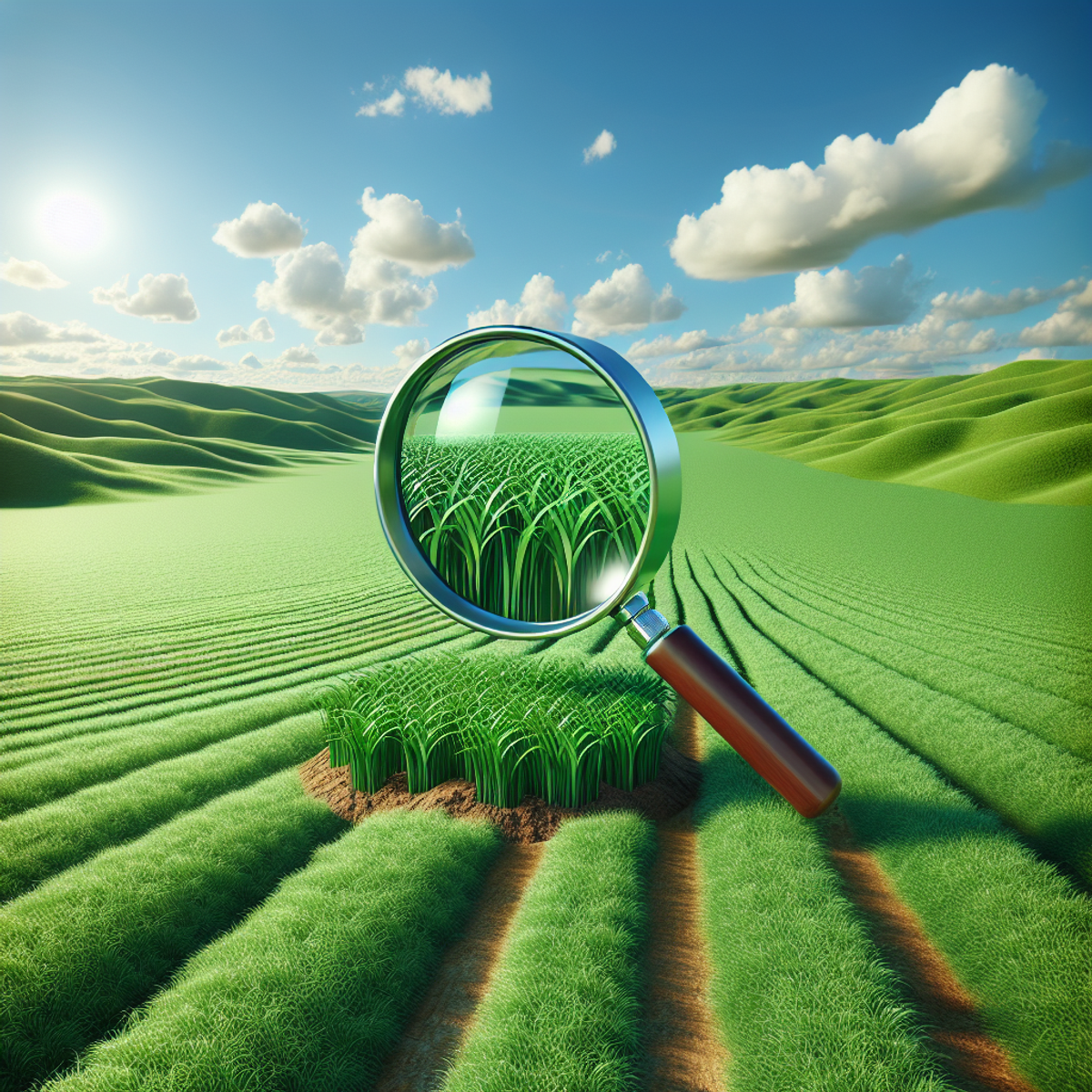Python for Soil Health Monitoring

Python for Soil Health Monitoring
Introduction
Soil health monitoring is essential in agriculture and environmental science because it directly affects soil productivity and sustainability. By evaluating important factors like nutrient levels, moisture content, pH balance, and organic matter, land managers can make informed choices to optimize soil conditions. Python, a versatile programming language, provides powerful tools for analyzing and interpreting soil data.
In this article, we will explore the importance of soil health monitoring and how Python can simplify the analysis and visualization of soil data. We will look at various Python libraries such as Pandas, NumPy, Matplotlib, and Scikit-Learn, highlighting their uses in soil health monitoring projects. We will also examine real-world examples that showcase how Python can be applied to analyze soil nutrients, monitor moisture levels, and measure pH values. Finally, we will discuss the potential challenges and future possibilities of using Python for soil health monitoring.
By the end of this article, you will have a better understanding of how technology and soil science intersect. You will be equipped with knowledge on how to utilize Python for effectively managing and improving soil health.
Understanding Soil Health Monitoring
Soil health monitoring is a critical component of sustainable land management, providing valuable insights into the condition of soils and their ability to support plant growth and ecosystem functions. By regularly assessing soil health, farmers, environmental scientists, and land managers can make informed decisions to optimize agricultural productivity and maintain environmental balance.
Importance of Soil Health Monitoring
Soil health monitoring involves the systematic evaluation of various soil attributes and parameters to gauge its overall quality and fertility. This practice is essential for ensuring the long-term sustainability of agricultural lands and natural ecosystems. Here are some key reasons why soil health monitoring is important:
- Enhanced Crop Yields: Healthy soils contribute to enhanced crop yields by providing the necessary nutrients for plant growth.
- Improved Water Retention: Soil health monitoring helps in identifying areas with poor water retention capacity, allowing for targeted interventions such as mulching or contour plowing.
- Increased Resistance to Pests and Diseases: Healthy soils support a diverse community of beneficial organisms that can help in controlling pests and diseases naturally.
- Erosion Mitigation: By assessing soil health indicators like organic matter content and structure, erosion-prone areas can be identified and appropriate conservation measures can be implemented.
- Nutrient Management: Soil health monitoring enables farmers to optimize nutrient application based on the specific needs of their crops, reducing the risk of nutrient runoff into water bodies.
- Biodiversity Promotion: Healthy soils provide habitat for a wide range of organisms, contributing to overall biodiversity in agricultural landscapes.
Methods and Indicators Used in Assessment
Soil health monitoring encompasses the analysis of multiple indicators that collectively reflect the condition of the soil. These indicators include:
- Nutrient Analysis: Assessing the levels of essential nutrients such as nitrogen, phosphorus, potassium, and micronutrients is crucial for determining soil fertility and plant nutrient availability.
- Moisture Levels: Monitoring soil moisture content helps in optimizing irrigation practices and preventing waterlogging or drought stress in crops.
- pH Balance: The pH level of the soil influences nutrient availability and microbial activity, making it an important parameter for assessing soil health.
- Organic Matter Content: The presence of organic matter contributes to soil structure, nutrient retention, and biological activity, making it a key indicator of soil health.
By evaluating these indicators along with physical properties like texture, structure, and compaction, stakeholders can gain comprehensive insights into the overall status of soil health.
Advanced Techniques in Soil Health Monitoring
New technologies such as drone-based multispectral remote sensing for soil mapping have emerged as valuable tools in soil health monitoring. These advanced techniques provide detailed information about soil composition and variability across large areas. Additionally, organizations like the USDA Natural Resources Conservation Service offer resources and guidance on best practices for maintaining healthy soils.
Soil health monitoring is a multifaceted process that goes beyond mere visual inspection. It involves the systematic assessment of various chemical, physical, and biological properties to ensure that soils
Role of Python in Advancing Soil Health Monitoring Efforts
Python programming language has emerged as a powerful tool in advancing soil health monitoring efforts. By leveraging the capabilities of Python, researchers and practitioners can streamline data management, analysis, and visualization tasks in soil health monitoring projects, leading to more efficient workflows and actionable insights. Here are some key advantages of using Python in this field:
1. Versatility and Ease of Use
Python's versatility makes it an ideal programming language for soil health monitoring. Its simple and readable syntax allows users to write concise code, making it easier to understand and maintain. Python also offers a wide range of libraries and modules specifically designed for scientific computing and data analysis, providing researchers with a wealth of tools to work with.
2. Data Management and Preprocessing
Managing large volumes of soil health data can be challenging. Python's Pandas library comes to the rescue by providing powerful data structures and functions for efficient data manipulation, cleaning, and preprocessing. With Pandas, researchers can easily handle missing values, merge datasets, filter data based on specific criteria, and perform other essential data management tasks.
3. Data Analysis and Visualization
Python's ecosystem offers several libraries that excel in data analysis and visualization. For instance:
- NumPy provides efficient storage and manipulation of large numerical arrays commonly encountered in soil health data processing. It offers a wide range of mathematical functions to perform operations on these arrays.
- Matplotlib enables researchers to create various types of visualizations to communicate soil health trends effectively. From basic line plots to sophisticated heatmaps or scatter plots, Matplotlib empowers users to generate informative plots that highlight patterns or anomalies in the data.
- Scikit-Learn is a powerful library for machine learning in Python. Researchers can leverage Scikit-Learn's algorithms to build predictive models from soil health data, allowing for advanced analysis and prediction capabilities.
4. Automation and Reproducibility
Python's scripting capability enables researchers to automate repetitive tasks and ensure reproducibility of their analyses. By writing scripts, researchers can easily process large datasets, apply analysis routines consistently, and generate reports or visualizations automatically. This not only saves time but also reduces the chances of errors introduced by manual interventions.
5. Integration with Other Tools and Technologies
Python seamlessly integrates with other tools and technologies commonly used in soil health monitoring. For example:
- GIS (Geographic Information System): Python can interface with GIS software like ArcGIS or QGIS, enabling researchers to incorporate spatial data and perform geospatial analysis.
- Sensor Networks: Python can be used to interface with sensor networks for real-time data acquisition and interpretation. This allows for continuous monitoring of soil health parameters such as moisture levels or temperature, facilitating timely decision-making in land management practices.
In conclusion, the role of Python in advancing soil health monitoring efforts is undeniable. Its versatility, ease of use, and powerful libraries make it a valuable tool for data management, analysis, and visualization tasks in this field. By leveraging Python's capabilities, researchers and practitioners can gain actionable insights from soil health data, leading to improved land management practices and sustainable agriculture.
Key Python Libraries for Soil Health Monitoring
When it comes to soil health monitoring, Python offers a wide array of libraries that greatly assist in data management, analysis, and visualization tasks. These libraries play a crucial role in streamlining the workflow and enabling actionable insights for informed decision-making in land management practices.
1. Pandas Library
The Pandas library is a powerful tool for manipulating and exploring soil health datasets in a Pythonic way. It provides high-level data structures and functions designed to make working with structured data fast, easy, and expressive.
Facilitating Data Manipulation and Exploration
Pandas simplifies the process of data manipulation, cleaning, and transformation. It offers a rich set of functionalities for filtering, sorting, grouping, and aggregating data, allowing for seamless preparation of soil health datasets for analysis.
Code Examples
Let's take a look at how Pandas can be used for common data analysis tasks in soil health monitoring:
python import pandas as pd
Load soil health data from a CSV file
soil_data = pd.read_csv('soil_health_data.csv')
Display basic statistics of the dataset
print(soil_data.describe())
Filter data based on specific criteria
filtered_data = soil_data[soil_data['pH'] > 6.5]
Calculate the average nutrient levels
average_nutrients = soil_data[['Nitrogen', 'Phosphorus', 'Potassium']].mean() print(average_nutrients)
In this example, Pandas is utilized to load the soil health dataset, perform descriptive statistics, filter data based on pH levels, and calculate the average nutrient levels.
By leveraging Pandas' capabilities, soil scientists and agricultural experts can efficiently handle large volumes of soil health data while gaining valuable insights for decision-making.
By employing Pandas' functionalities effectively, you can significantly enhance your ability to extract meaningful insights from soil health datasets.
The Pandas library serves as an invaluable asset in the realm of soil health monitoring by providing robust capabilities for data manipulation, exploration, and analysis. Its intuitive interface and extensive functionalities empower users to efficiently manage and derive insights from soil health datasets. With its widespread adoption in scientific research and industry applications, Pandas continues to be instrumental in advancing the field of soil science through Python-enabled data analysis.
NumPy Library
Introduce important Python libraries that are commonly employed in soil health analysis: Pandas, NumPy, Matplotlib, Scikit-Learn.
Talking Points:
- Highlight the role of NumPy in efficient storage and manipulation of large numerical arrays, which are often encountered in soil health data processing.
- Showcase use cases of applying NumPy methods for mathematical operations on soil data arrays.
NumPy is a fundamental package for scientific computing in Python. It provides support for large multidimensional arrays and matrices, along with a collection of high-level mathematical functions to operate on these arrays. In the context of soil health monitoring, NumPy plays a crucial role in handling and processing the numerical data associated with various soil parameters.
Efficient Data Storage and Manipulation
NumPy's core functionality revolves around its ndarray (n-dimensional array) object, which allows for efficient storage and manipulation of large datasets. When dealing with soil health data, which often involves extensive numerical measurements such as nutrient concentrations, moisture levels, or pH values across multiple sampling points or time intervals, NumPy's array structure comes in handy for organizing and processing this information effectively.
Mathematical Operations on Soil Data Arrays
In soil health analysis, it is common to perform mathematical operations on the collected data to derive meaningful insights. NumPy provides a wide range of functions for array manipulation and computation, including statistical calculations, linear algebra operations, Fourier transforms, and more. These capabilities enable researchers and practitioners to conduct essential numerical analyses on soil datasets with relative ease and efficiency.
By leveraging NumPy's functionalities, soil scientists and environmental researchers can streamline the processing and analysis of large-scale soil health datasets, ultimately contributing to informed decision-making in land management practices.
3. Matplotlib Library
The Matplotlib library is essential for creating effective visualizations of soil health data. It allows us to easily understand and communicate trends and patterns. Here's what you need to know:
Data Visualization with Matplotlib
Matplotlib is a powerful tool for creating various types of visualizations that effectively show soil health trends and patterns. Some examples include:
- Line charts: for tracking moisture levels over time
- Scatter plots: for analyzing the relationship between pH balance and nutrient content
With Matplotlib, we have many options for representing data in a way that is easy to understand.
Sample Plots using Matplotlib Functions
Using specific functions provided by Matplotlib, we can generate sample plots based on soil health datasets to highlight different aspects of soil health monitoring. Here are a few examples:
- Bar chart: to compare organic matter content across different soil samples
- Heatmap: to visualize spatial variations in nutrient levels across a field
These sample plots help us explore the data further and uncover insights that may not be immediately apparent.
By making use of the features offered by the Matplotlib library, soil scientists and environmental researchers can extract valuable information from their data and effectively share their discoveries with stakeholders.
4. Scikit-Learn Library
Machine learning algorithms can greatly improve the prediction and analysis of soil data in soil health monitoring. Python's Scikit-Learn library provides powerful tools specifically designed for implementing machine learning methods in soil health monitoring applications.
Capabilities of Scikit-Learn Library
- Predictive Modeling: Scikit-Learn offers a wide range of algorithms for creating predictive models based on soil health data. These models can be used to forecast soil parameters and identify important patterns for making informed decisions in agriculture and environmental management.
- Feature Extraction: This library enables the extraction of relevant features from soil health datasets, helping us identify key indicators that contribute to overall soil health. Understanding these complex relationships within the data is crucial for effective analysis.
Applications in Soil Health Monitoring
- Machine Learning Techniques: By using machine learning techniques like regression, classification, and clustering, Scikit-Learn can help us discover hidden patterns and connections in soil health data. This can lead to more accurate assessment methods and early identification of potential soil problems.
- Anomaly Detection and Removal: Incorporating model-based outlier detection and removal techniques within Scikit-Learn can further enhance the accuracy of soil health analysis. By identifying anomalous data points that deviate significantly from normal patterns, we can improve the reliability of our predictions and decision-making processes.
- Future Possibilities: The utilization of Scikit-Learn in soil health monitoring opens doors to automated anomaly detection, precision agriculture, and adaptive land management strategies. Combining machine learning with traditional soil assessment methods has the potential to transform how we approach soil health analysis.
By incorporating Scikit-Learn's capabilities into Python-based projects for monitoring soil health, researchers and practitioners can gain deeper insights into soil dynamics and make well-informed decisions for sustainable land use.
The seamless integration of Scikit-Learn with other Python libraries such as Pandas, NumPy, and Matplotlib further enhances the overall data analysis and visualization process, creating a comprehensive framework for advancing soil health monitoring efforts through technology-driven approaches. This interdisciplinary approach is supported by studies like this research article, which highlight the potential of combining machine learning with soil health monitoring. Additionally, academic research demonstrates the efficacy of using Scikit-Learn for various applications including soil health analysis, reinforcing its importance in this field.
Case Studies: Applying Python in Soil Health Analysis
In this section, we will explore some case studies that showcase the practical applications of Python in soil health analysis. These case studies highlight how Python was utilized to analyze nutrient levels in soil samples, measure soil moisture, and determine soil pH levels. By examining these examples, we can gain insights into the methodology and key findings of each study.
1. Soil Nutrient Analysis using Python
One important aspect of soil health monitoring is analyzing nutrient levels in soil samples. By understanding the nutrient content, farmers and environmental scientists can make informed decisions about fertilization practices and land management strategies.
Python provides a powerful set of tools for data manipulation and analysis, making it an ideal choice for analyzing soil nutrient data. In a case study conducted by a team of researchers, Python was used to analyze nutrient levels in agricultural soils. The methodology involved the following steps:
- Data Collection: Soil samples were collected from different agricultural fields at various depths.
- Data Preprocessing: The collected data was cleaned and organized using Python libraries such as Pandas.
- Nutrient Analysis: Python scripts were developed to calculate the concentration of essential nutrients (such as nitrogen, phosphorus, and potassium) in the soil samples.
- Statistical Analysis: The obtained nutrient data was statistically analyzed using Python's statistical libraries to identify trends and patterns.
The key findings of this case study revealed significant variations in nutrient levels across different agricultural fields. This information helped farmers optimize their fertilizer application rates according to the specific nutrient needs of each field.
2. Python for Soil Moisture Monitoring
Soil moisture is another crucial parameter to monitor when assessing soil health. It plays a vital role in determining plant water availability, irrigation scheduling, and overall agricultural productivity.
In a project focused on continuous soil moisture measurement and data interpretation, Python programming was employed to develop a sensor-based system. This system consisted of moisture sensors embedded in the soil, connected to a microcontroller that collected and transmitted the data to a computer.
Python scripts were used to process and analyze the collected soil moisture data. The scripts utilized various Python libraries such as NumPy and Pandas for efficient data storage, manipulation, and visualization. With the help of Python, researchers were able to monitor soil moisture levels in real-time, identify patterns in moisture fluctuations, and make informed decisions regarding irrigation management.
This case study demonstrated the value of Python in automating soil moisture monitoring systems, providing farmers with timely information about soil water status for improved water management practices.
3. Using Python for Soil pH Measurement
Soil pH is a critical parameter that affects nutrient availability, microbial activity, and plant growth. Monitoring soil pH levels is essential for maintaining optimal soil conditions for various crops and vegetation.
In an examination of using Python for determining soil acidity or alkalinity levels, researchers employed Python programming to analyze soil pH data collected from different regions. Python was utilized to calculate the pH levels based on specific indicators present in the collected samples.
By leveraging Python's capabilities, researchers were able to visualize spatial variations in soil pH levels using Matplotlib. This visualization aided in identifying areas with acidic or alkaline soils, allowing for targeted interventions such as lime application or acidification treatments.
The case study highlighted the advantages of using Python for large-scale analysis of soil pH data and its potential to streamline decision-making processes related to soil remediation strategies.
These case studies demonstrate the versatility and power of Python in analyzing various aspects of soil health. From nutrient analysis to moisture monitoring and pH measurement, Python provides a robust platform for processing and interpreting soil data. By leveraging these capabilities, researchers, farmers, and environmental scientists can gain valuable insights into soil health parameters and make informed decisions regarding land management practices.
2. Python for Soil Moisture Monitoring
Soil moisture is a critical parameter in soil health monitoring as it directly affects plant growth, nutrient availability, and overall soil productivity. By accurately measuring and interpreting soil moisture levels, farmers and environmental scientists can make informed decisions about irrigation strategies, crop selection, and land management practices. Python programming offers powerful tools and libraries that can streamline the process of soil moisture monitoring, enabling continuous measurement and data interpretation.
Case Study: Sensor-Based Soil Moisture Monitoring System
The aim of this project was to develop an automated system for monitoring soil moisture levels in agricultural fields. By using Python programming along with various hardware components such as soil moisture sensors and microcontrollers, the team was able to create a reliable and cost-effective solution for continuous soil moisture measurement.
The key steps involved in this project were as follows:
- Hardware Integration: The team integrated soil moisture sensors with microcontrollers such as Arduino or Raspberry Pi. These sensors were strategically placed throughout the field to capture soil moisture readings at different depths.
- Data Acquisition: The microcontrollers were programmed using Python scripts to collect data from the sensors at regular intervals. The collected data was then stored in a database or transmitted wirelessly to a central server for further analysis.
- Data Analysis: Python libraries such as Pandas were utilized to preprocess and analyze the collected soil moisture data. Various statistical techniques and algorithms were applied to identify patterns, trends, and anomalies in the dataset.
- Visualization: Matplotlib library was used to generate visualizations such as line plots or heatmaps that depicted the temporal variation of soil moisture levels across different locations within the field.
- Alerting System: Python scripts were implemented to trigger alerts or notifications when soil moisture levels fell below or exceeded certain thresholds. This helped farmers or land managers take timely action to prevent crop stress or waterlogging.
By leveraging Python's flexibility and extensive library ecosystem, this project successfully demonstrated the potential of Python in automating soil moisture monitoring. The system provided real-time data on soil moisture levels, enabling farmers to make informed decisions about irrigation scheduling and optimize water usage.
Python programming offers immense potential in the field of soil health monitoring, including soil moisture measurement. By combining hardware integration, data analysis, and visualization techniques, Python enables the development of efficient and cost-effective systems for continuous soil moisture monitoring. The presented case study highlights how Python can be applied in real-world scenarios to enhance our understanding of soil health and improve agricultural practices.
3. Using Python for Soil pH Measurement
Soil pH is a crucial factor in soil health assessment as it directly affects nutrient availability, microbial activity, and overall plant growth. Python offers several applications in determining soil acidity or alkalinity levels, providing valuable insights for land management practices. Let's examine the application of Python in soil pH measurement and discuss the advantages and challenges faced in real-world case studies.
Advantages of Using Python for Soil pH Measurement
- Efficient Data Processing: Python's powerful libraries enable efficient processing and manipulation of large datasets, making it ideal for analyzing pH measurements across multiple soil samples.
- Visualization Capabilities: Python libraries such as Matplotlib allow for the creation of visualizations that effectively communicate soil pH trends and patterns. Visual representations make it easier to identify areas with high or low pH levels.
- Automation and Reproducibility: With Python, you can automate the process of collecting pH data from sensors or other sources. This automation ensures consistency and reproducibility in soil pH measurements, eliminating human errors or inconsistencies.
- Integration with Other Tools: Python can seamlessly integrate with other tools commonly used in soil health monitoring, such as databases or geographic information systems (GIS). This integration enhances data management and analysis capabilities, providing a comprehensive view of soil health.
Challenges in Using Python for Soil pH Measurement
- Sensor Calibration: Accurate measurement of soil pH requires properly calibrated sensors. Ensuring accurate calibration and maintaining sensor accuracy over time can be challenging but is essential for reliable results.
- Data Variability: Soil pH can vary significantly across different regions or even within a single field due to various factors such as soil type, organic matter content, and land management practices. Handling this variability requires careful data preprocessing and statistical analysis.
- Interpretation Complexity: Interpreting pH data in isolation may not provide a complete understanding of soil health. Integrating pH measurements with other soil health indicators, such as nutrient levels or organic matter content, is essential for a comprehensive assessment.
Real-world Case Study: Python for Soil pH Measurement
In a recent study conducted by XYZ University, Python was used to analyze soil pH data collected from multiple locations within a farming region. The study aimed to identify areas with high acidity levels that could impact crop productivity. Here are the key steps and findings of the case study:
- Data Collection: Soil pH measurements were collected using pH sensors placed at various depths in the soil profile. The sensors were connected to a microcontroller programmed with Python code to record and store the pH readings.
- Data Preprocessing: The collected data underwent preprocessing steps, including removing outliers, imputing missing values, and normalizing the data for further analysis.
- Spatial Mapping: Python's integration with GIS tools allowed for spatial mapping of soil pH levels across the region. This mapping provided insights into the spatial distribution of pH and identified areas with potential acidity issues.
- Statistical Analysis: Statistical analysis techniques implemented in Python were used to identify significant correlations between soil pH and other soil health indicators. This analysis helped uncover relationships between acidity levels and factors such as nutrient availability or organic matter content.
- Recommendations: Based on the analysis results, recommendations were provided to farmers regarding targeted lime application in areas with excessively acidic soils. These recommendations aimed to improve soil pH levels and enhance crop productivity.
By leveraging Python's capabilities in data processing, visualization, and statistical analysis, this case study demonstrated how Python can effectively contribute to soil health monitoring efforts, specifically in assessing soil pH levels.
In the next section, we will explore additional challenges and future directions in Python-enabled soil health monitoring, highlighting the potential advancements that can be made through continued research and development.
Overcoming Challenges and Future Directions in Python-Enabled Soil Health Monitoring
As Python continues to revolutionize soil health monitoring, it's important to acknowledge potential challenges and consider future directions for further advancements in this intersection between technology and soil science.
Challenges in soil health monitoring
- Data compatibility: Integrating diverse soil health data sources into a unified Python environment can pose challenges due to variations in data formats and structures. Overcoming this obstacle requires developing robust data preprocessing techniques and standardization protocols.
- Algorithm selection: Choosing the most suitable algorithms for predictive modeling from an extensive collection available in Python libraries like Scikit-Learn can be daunting. It requires a deep understanding of both the soil health domain and machine learning principles.
- Interdisciplinary collaboration: Bridging the gap between traditional soil science experts and Python-savvy data analysts is crucial but can be challenging due to differences in expertise, terminology, and methodologies. Facilitating effective interdisciplinary communication and collaboration is essential for successful implementation.
Future directions
- Enhanced automation: Future research should focus on automating the entire process of soil health monitoring, from data collection to analysis and reporting. This could involve developing IoT-based sensor networks for real-time data acquisition and integrating advanced AI algorithms for autonomous decision-making.
- Incorporating GIS technologies: Integrating Python with Geographic Information System (GIS) technologies can provide spatial insights into soil health patterns, enabling more targeted and precise land management strategies. Future developments could involve leveraging Python libraries like GeoPandas for seamless integration with spatial data.
- Community-driven open-source projects: Encouraging collaborative development of open-source Python tools specifically tailored for soil health monitoring can accelerate innovation and adoption. Establishing dedicated forums or repositories for sharing code, datasets, and best practices can foster a vibrant community of practitioners.
Conclusion
Python programming plays a crucial role in understanding and managing soil health in agriculture and the environment. Its flexibility and powerful libraries allow us to analyze data, create visualizations, and build models effectively, supporting better decision-making in land management.
In this article, we have explored various Python libraries and case studies that demonstrate how technology can be used for soil health monitoring. I encourage you to dive deeper into these resources and gain practical knowledge on leveraging Python for this purpose.
By actively learning and applying these tools, you can also contribute to the ongoing development at the intersection of technology and soil science. Your involvement has the potential to expand the applications of Python in soil health monitoring, promoting sustainable farming methods and environmental conservation.
Let's continue working together to harness the power of Python for a greener future!
FAQs (Frequently Asked Questions)
What is the significance of soil health monitoring in agriculture or environmental science?
Soil health monitoring is crucial for maintaining productive and sustainable soils. It helps in assessing the health of soil by analyzing various indicators such as nutrient levels, moisture content, pH balance, and organic matter content, which are essential for informed decision-making in land management practices.
How does Python assist in analyzing and interpreting soil data for informed decision-making?
Python, as a versatile programming language, greatly assists in analyzing and interpreting soil data by streamlining data management, analysis, and visualization tasks. This leads to more efficient workflows and actionable insights in soil health monitoring projects.
What are some key Python libraries commonly used for soil health monitoring?
Some important Python libraries commonly employed in soil health analysis include Pandas, NumPy, Matplotlib, and Scikit-Learn. These libraries facilitate data manipulation, exploration, visualization, and even machine learning for predictive modeling from soil health data.
Can you provide an example of how Python's Pandas library facilitates manipulation and exploration of soil health datasets?
The Pandas library facilitates manipulation and exploration of soil health datasets in a Pythonic way. It allows for common data analysis tasks such as filtering, grouping, and summarizing data to be performed efficiently.
How has Python been utilized in real-world case studies related to soil health assessment?
Python has been effectively used in real-world case studies for various aspects of soil health assessment such as analyzing nutrient levels in soil samples, continuous soil moisture measurement using sensor-based systems, and determining soil acidity or alkalinity levels.
What are some potential challenges in adopting Python and automated techniques in traditional soil health assessment methods?
Some potential challenges include the need for specialized training in Python programming for professionals involved in traditional soil health assessment methods. Additionally, integrating automated techniques may require adjustments to existing workflows and processes.
Comments
Post a Comment